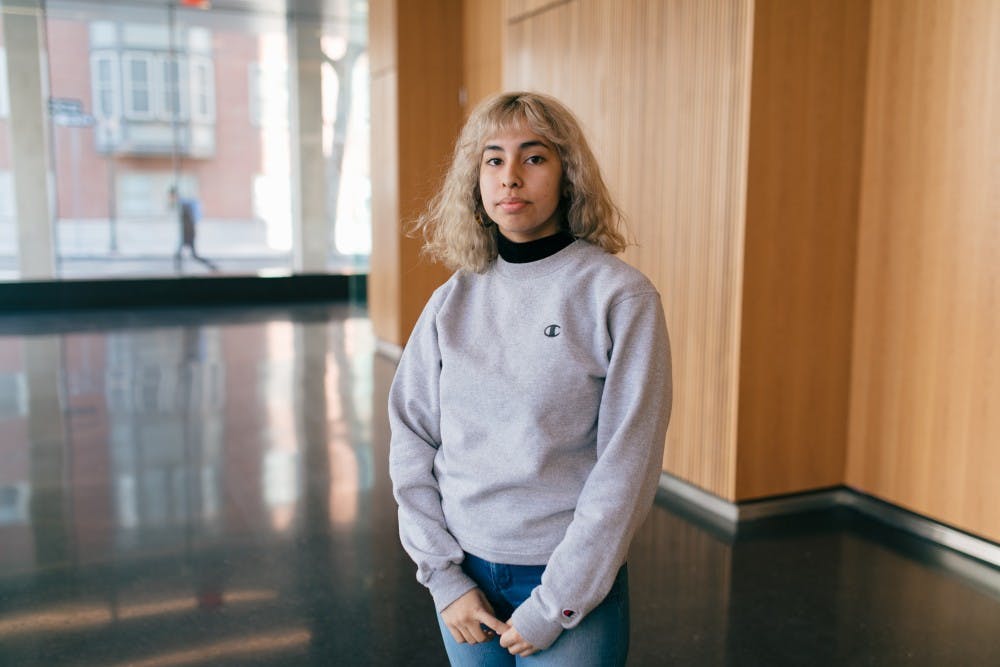It is the summer of 2016, I am fifteen and, like everyone else who has ever traversed through adolescence, I am knee–deep in an emo phase. My playlists cycle through the same artists who comprise the emo canon—My Chemical Romance, Fall Out Boy, Panic! At the Disco—and I beg my parents for Warped Tour tickets with desperate fervor. I mold myself to fit the stereotype of the misunderstood teenager so well, save for one detail: I am Hispanic, and Hispanic girls aren’t allowed to like punk music.
I remember learning this while I sat on the scorching sidewalk of Manhattan’s 15th St., awaiting a coveted front row spot at a Modern Baseball concert. Thoughtful yet unequivocally badass, this band represented everything I wanted to be as a poser punk: cool, introspective, and effortless. Even now, three years later, I can still feel the mounting anticipation of those two and half hours spent in front of Irving Plaza and the dedication that pooled, like sweat, on the necks and foreheads of myself and my two friends, a pair of suburban Hispanic girls with hidden punk affinities. We were ready to prove our worthiness, to claim our spot in a fandom populated by people just like us. Only, at the time, we didn’t realize that spot wasn’t ours to claim.
At some point in our waiting, a journalist emerged from a sleek, black Jeep and began interviewing members of the pre–show crowd about why they love Modern Baseball, about the band’s influence, and about their perceptions of pop–punk’s new frontier. This should have been my moment—I was first in line, outfitted in the standard careless concert–going outfit of a white tee, black shorts, and Converse, and full of opinions about everything. But the interviewer passed over my friends and me like we were invisible, part of a null background. Nothing differentiated us from the trail of girls behind us, save for one thing: their porcelain skin blistered in the New York City sun and ours tanned. We were not white, and thus, we were not punk.
This feeling of blistering exclusion, of bolded otherness, isn't uncommon. As a person of color, it often feels like the music industry doesn't absorb me and the communities I belong to into its widening folds. Whether enveloped in the crowd at a concert or blaring music alone in our rooms, some people of color feel like our music tastes are something we stumbled upon in spite of a world that pushes us toward hip–hop, reggaeton, and anything but "white people music." Now, being a super–fan comes with monetary expectations: buying the most merch, getting floor seats at concerts, or shelling out hundreds for a meet and greet. And as fandom becomes coded along socio–economic and racial lines, these communities begin to feel exclusionary.

Sharon Zea Rincon (C ‘21), a Hispanic student and the host of WQHS' Some Milky Shit, best describes her go–to genre as "moany indie music." "It wasn't until I got to Penn that I met people of color who liked the same genre of music as I did," said Sharon, mentioning that indie genres are dominated by white and straight artists. Growing up in West Philadelphia while attending a private school teeming with affluence, Sharon remembered that the only classmates who understood her music were white.
"My brothers were always on me, like, 'Sharon, why don't you listen to more reggaeton or hip–hop?'" Sharon says, "all of my friends from home were like, 'You're white now. You listen to white music. What's going on?'" She guessed that her tastes arose from adapting to white spaces like her school and the areas around it. But rather than feeling out of place in the white dominated world of whiny indie, Sharon feels most "like an outsider within the Hispanic community." Sharon and I represent two sides of the same coin, with our tastes separating us from some of the things we want to love most. For her, it's the culture she grew up in. For me, it's the music communities I still want to belong to.
Jacob Brown (C ‘22), a half–black student, faces a similar challenge. Worshipping at the altar of canonical indie bands like The Strokes and Arctic Monkeys, he realized that this music isn't exactly made for him. He defines ‘white people music’ as "stuff that speaks to white experiences."

Now, I’m no stranger to the contours of “white people” music. I spent my formative years memorizing Taylor Swift lyrics instead of multiplication tables, reciting Ed Sheeran trivia with embarrassing accuracy, and developing a penchant for indie bands filled with pastiches of Brooklyn–hipster types. I’ve been the Hispanic fangirl at nearly every concert I’ve ever attended, always aware of some implicit rule about who can and can’t listen.
I claim this uniqueness as part of my identity, glossing over the stereotype–tinged shock my first boyfriend had when I told him, “I don’t really listen to hip–hop.” I conditioned myself to feel comfortable in implicitly white–only spaces, using obsession to legitimize my spot in fandoms associated with middle class, white childhood. I didn’t develop an encyclopedic knowledge of Taylor Swift’s girl squad or create conspiracy theories about Lorde’s secret romances because I wanted to. I did it because I thought I had to.
Maya Patel (C ‘22) identifies as Indian–American, and carries this same burden. A fellow Swiftie, we quickly bonded over a lifelong infatuation with epic love songs, vanilla–tinted fantasies, and Swift's brand as "America's everygirl." Our entire conversation took on a subtle tinge of competition, with us listing the fandom dramas we witnessed firsthand with stunning accuracy. It was almost as if we were both 14 and addicted to Tumblr again, trying to prove to the other blogs that we were more dedicated than the rest.
Maya wants to preserve her relationship with Swift, even if it’s one that no longer feels as natural as it did a decade ago. Maya tells a nostalgia–tinted story about seeing the Reputation World Tour at Metlife Stadium last summer. She mentions looking out at the crowd between songs and feeling somewhat underrepresented within the predominantly white audience, but ultimately ignoring it. "I definitely put on rose–colored glasses in that moment. It didn't matter because Taylor was on stage, singing to me."
Maya was able to appreciate the concert in spite of feeling like she was one of the only people of color in the space. I've felt that way too. But newsflash: the burden of representation shouldn’t fall on impressionable young fans. We aren’t here to fill a diversity quota, and we don’t have to justify our preferences. We’re just here to listen to music. And to allow for that, artists must commit to inclusivity. How can they do that? Namely, by redefining what it means to be a fan.

Fanaticism is quickly becoming the survival of the richest, with fans who lack economic stability treated like the casual listener. In a society where white families have nearly ten times the wealth of black families, this distinction feels discriminatory. It feels as though artists are homogenizing their fanbases to include those who fit the profile—rich, independent, and by happenstance, white.
Leading up to her Reputation World Tour, Swift released tickets on a tiered basis, with more “committed” fans getting a crack at early releases. Swift defined commitment monetarily, with the amount of money spent on official merch determining your spot in the queue. In other words, fans with the socioeconomic stability to buy Reputation 13 times or shell out $60 for a tacky, snake–shaped ring were prioritized over those who could only afford to stream Swift’s free YouTube videos.
Meanwhile, The National, one of the rare indie bands with more than a decade of relevance, runs a membership–based fan club in which members pay fifty dollars per year for limited–edition vinyls, exclusive content, and priority ticketing. The 1975 romanticize the nomadic fan, the type of listener who can afford to shelve her life for a tour cycle. Compared with 12% of white college graduates, 21% of Hispanic grads will default on student loan debt, making the idealized image of the unburdened groupie seemingly unfeasible.
So much of the teenage experience is marked by the desire to be let in, to be included in something bigger than high school cliques. Fandoms provide the pathway for this kind of acceptance, and it could dishearten young listeners of color to see themselves systemically prohibited from accessing small joys, like listening to your favorite artist’s new song on the day it’s released.
That’s just part of the reason why I’ve never really felt welcome in these indie and punk spaces, from arena concerts to Tumblr fan blogs.
In order to be inclusive, musicians need to revert to the old criterion for fanaticism—dedication. Rather than rewarding listeners who have the means to mindlessly click an “Add to Cart” button, musicians should reward the listener who has embedded the best parts of their catalog into their identities.
These fans aren’t always the white, suburban, wealthy teens that so often fill up the fields of Coachella VIP seating areas. These are the fans who wait in line for hours through sweltering urban heat, pirate music off of YouTube in secret, and treat even the most mundane of merch like it’s a collectible. I know because I'm one of them.
Beatrice Forman is a freshman in the College. She is a music beat for Street.
